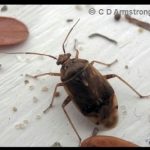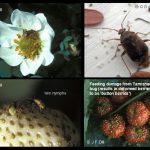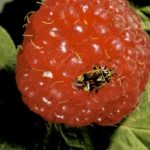Tarnished Plant Bug

The Tarnished Plant Bug (Lygus lineolaris) is a member of the Miridae–or true bugs–family of insects. It can be found throughout North America, with a range that extends from northern Canada to southern Mexico, and is a serious pest on small fruits and vegetables with a staggering host range. It is reported to feed on over 50% of North American commercially grown crop plants, including a very high number that are deemed economically important. It has a particular fondness for cotton, alfalfa (especially when it begins to flower), beans, stone fruits, and conifer seedlings. In our part of the world, it feeds on most of our vegetable and fruit crops (apples, peaches, strawberries, raspberries [sometimes], brambles, carrots, lettuce, eggplant, beans, tomatoes, potatoes, asparagus, celery, cauliflower, broccoli), alfalfa–as mentioned above–and many of our garden plants such as asters, dahlias, marigolds, zinnias, sunflowers, sage, and snapdragons. This bug often begins its development on native wildflowers and other plants in the spring (late April – early May) in areas often described as weedy patches, and as their populations build, they will then spill over and, unfortunately for farmers and gardeners alike, discover additional plants that are to their liking.
Tarnished plant bugs overwinter as adults, and become active as soon as temperatures allow. They mate and the females lay their eggs inside various portions of plant tissue, such as the insides of buds, young stems, or leaf veins. Eggs can hatch in only five to seven days, and the resulting nymphs go through a total of five instars on their way to adulthood, but since they can reproduce and reach adulthood fairly quickly, anywhere from two to five generations can occur throughout the growing season.
Tarnished plant bug nymphs and adults feed by way of piercing-sucking mouthparts that enable them to drink the sap from their chosen and/or host plants. They exhibit a preference for the most succulent and nutritious portions of the plant–the buds, flowers, newly developing fruit, and/or plant terminals. Thus, even at low population densities, they can inflict a significant level of economic damage. Fruits, for example, may be deformed. Young fruit or buds that are injured are often aborted by the plant. Other outcomes and symptoms of their feeding may include necrosis near the feeding site, damage to seeds, and/or reduced or deformed vegetative growth which can include tip die-back when the tips are fed upon.
- Tarnished Plant Bug
- Tarnished Plant Bug (pest of many crops, especially strawberries and apples)
- Tarnished Plant Bug on a raspberry
- White sticky trap used to catch Tarnished Plant Bugs for monitoring purposes in a tree orchard setting.
Additional Information:
- Tarnished Plant Bug (Cornell)
- Tarnished Plant Bug (Penn State)
- Recognizing Tarnished Plant Bug Damage (University of Vermont)
- Tarnished Plant Bug Traps [YouTube video] (University of Vermont Fruit Program)




